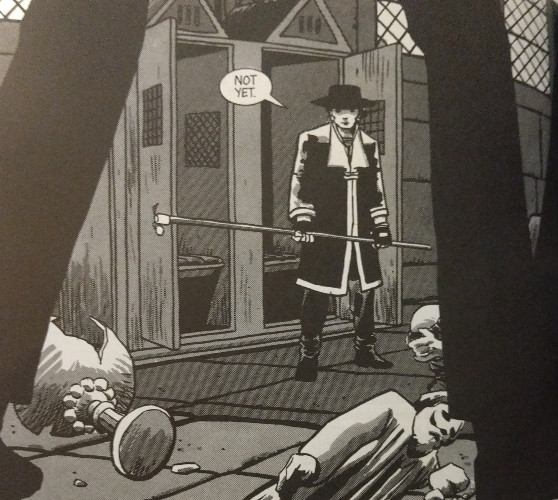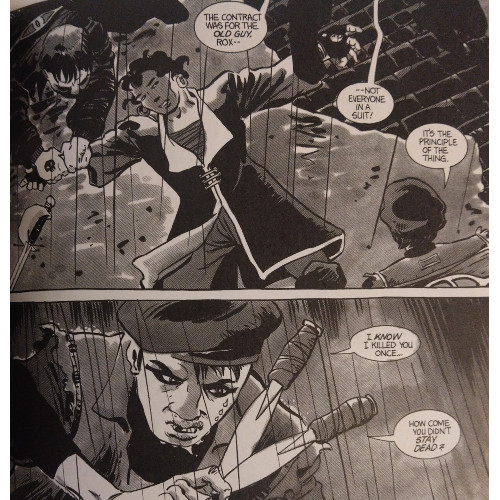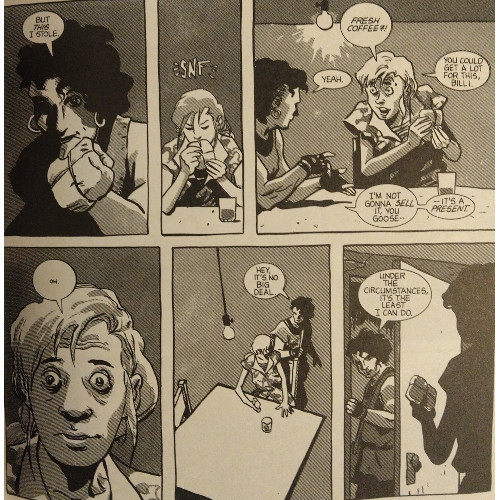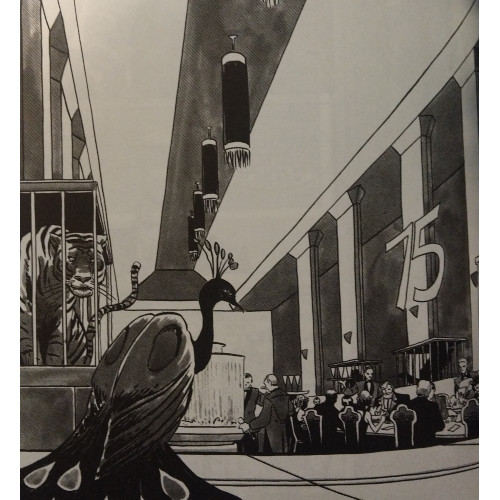Random Reviews: Billi 99
A somewhat unsatisfying vigilante narrative cannot enshroud the early styles of a celebrated artist
—by Nathan on November 4, 2025—

My recent re-readthrough of Jeph Loeb and Tim Sale's classic Halloween narratives in Batman: Haunted Knight reinvigorated the love I have for Sale as an artist. Though the man is no longer with us, he left us an impressive catalogue of material to dive into, mainly his collaborations with Jeph Loeb on Batman, Superman, and assorted Marvel characters.
But Sale, as I've seen digging into his bibliography, did more than just a spate of superhero comics for the Big Two publishers. Check out his work with Jim Lee and Brandon Choi on Deathblow for Image, which Sale's pencils are given a great opportunity to shine when provided a limited color palette. And if you want to traipse back even further, you'll eventually find Billi 99, a four-issue limited series Sale co-created and published with Dark Horse, the focus of today's review.
Sale, I recently learned, had a type of colorblindness, which makes for an interesting coincidence when you remember his and Loeb's "color" narratives for Marvel. But it also taps into a mindset concerning how he approached comics and constructed them–in one interview from years ago re-published shortly before he passed, Sale noted that "the point of comics is not the color." Unable to see them quite the same as other people, Sale understood other facets he needed to focus on, which can be seen dramatically in his remarkable linework. It makes me wonder if that's one reason why Billi 99 is entirely black-and-white. It best represents the medium he most comfortably worked in.
A stark difference visually from Sale's other narratives, Billi 99, written by Sarah E. Byam, is also topically different from Sale's contributions to superhero comics. Sure, some similarities exist–our main character dresses as a vigilante to aid the downtrodden–but as we are to see, Billi and her vendetta exist in a world far different from one where a millionaire orphan dresses as a winged creature to dish out justice to waddling men and cat burglars.
Billi 99
Writer: Sarah E. Byam
Penciler: Tim Sale
Inker: Tim Sale
Letterer: Tim Sale
Issues: Billi 99 #1-4
Volume Publication Date: October 2002
Issue Publication Dates: September 1991-December 1991
Publisher: Dark Horse Comics

This isn't meant as a criticism of the comic itself, but I believe any ongoing discussion surrounding this series is perpetuated and possibly maintained thanks to Sale's meteoric rise in the late 90s while working with Loeb. The story garnered interest at the time of publication, being nominated for three Eisner awards, and it was published in trade in 2002 (buyer beware: this review is of the second copy I purchased, as the first fell apart in my hands as soon as I cracked the spine); a more recent hardcover edition collects the full series in a colorized edition. I doubt it would receive as much attention as it has were it not for Sale's developing career, which I will note is very nice for both Sale and writer Byam.
Billi 99, if we're talking in terms of quality, is not necessarily a bad series. But it exists in this odd space, in my own purely subjective opinion, between an engaging story with resonant themes and an artifact of its era. There are elements which I found I appreciated, but there are also elements which I won't be putting into my deep memory or addressing with a great amount of attention. Again, I don't wish to slight either Byam or Sale, but I finished Billi 99 feeling, as Robin from Young Justice might say, "whelmed."

The narrative features a young woman, the eponymous Billi, on the run from the law as she tries to fight the criminal underworld of a future dystopian Detroit as a costumed vigilante, a role her father held until his death (read: his murder). Billi is also of interest to a company her father oversaw, which she has stock in, though she's clearly made the choice to separate herself from the skyscraper and glass window lifestyle. Billi is sympathetic enough–she lives among poorer folk, helps people out as best she can, swings a sword in the name of justice for the little guy–which is really the best I can say about her character. I'd say she's almost the female version of V from Alan Moore and David Lloyd's V for Vendetta, without all the highfalutin classical music references, cunningly placed explosions, and downright frustrating moral ambiguity.
It almost seems easily cruel to reference a classic work of graphic literature in comparison to this narrative, because Billi 99 feels torn from several ideas found in a variety of futuristic, dystopian series. The plucky protagonist on the lam; the big corporation with the cops in its pockets out to get her; the opulence of the upper classes contrasted with the plight of the underfed, oppressed, poor masses. Class discrimination plays an appropriately heavy theme, and Byam can handle this with nuance at times and make you easily empathize with the characters who live in poverty or feel neglected or pushed around by upper class business types. This is an unfair society we're dealing with, and Byam can nicely convey in her characters emotions real people would genuinely feel at times.
But we've seen this all before.

There are, engagingly, ideas which do feel particularly unique to Billi 99. As noted, Billi's father was a businessman-turned-vigilante, and one could read this as a "What If-?' story asking what would happen if Batman had a daughter who took over his role as protector of Gotham City after his death. The plot lends itself strength through Billi's devotion to her father and her determination to find his killer. Additionally, Byam allows some time for a subplot involving a serial killer to create tension, weaving it fairly closely to the main plot that it doesn't take over the story. Part of that subplot involves some interesting circumstantial irony developed between characters for a time, resulting in a complete betrayal of trust which works fairly well in the moment it occurs.
Engaging as these ideas are, there is a part of me that wishes Byam had allowed more time for both concepts to flourish as she juggled the main plot surrounding Billi's vigilante activities and her involvement with her father's corporation. Her father's ghost, in a figurative sense, haunts these pages, providing a decent impetus for most everything our other characters do, from Billi to a few of our bad guys, during the series. He's incredibly important, but aside from a few flashback panels, we never really grasp the full weight of his impact on the city as both a businessman and a vigilante. That may be intentional on Byam's part–she wants us to believe that Billi's love for her father is so total that she takes on his mantle as a way to honor his legacy, despite our own limited opportunities to know him. It's like an Uncle Ben/Peter Parker situation: by time Ben dies, just a few pages after he debuts, you're meant to believe Peter's love for him is complete and drives his future from that moment forward. I found I mostly trusted Billi's motivations but was left wishing we could see more of who her father was to gain a better understanding of the totality of his influence.

Likewise, the serial killer subplot, though undoubtedly creepy for a few reasons, feels more coincidental than intentional; late in the narrative, it actually becomes an incredibly important plot point and makes me wonder if Byam brought it into the series in order to have this point hinge on the killer's identity. It's not a murder mystery, necessarily, in that the reader is made aware of the killer's identity fairly shortly into the narrative. The subplot does filter into this theme of classism Byam injects into the story–without spoiling much, I'll just note that the killer is a member of the higher class and seems to enjoy, it's implicated, a certain freedom by indulging in darker urges through murder without fear of being caught because of his name and status within society. The idea is terrifying but feels misapplied as a subplot upon which the tale's third act rests. It deserved more attention and time.
I would not have minded it if the series ran longer than four issues. Byam does know the tale she wants to tell, and she does create a complete, somewhat compelling narrative. I just found that, with all the various plot points rampaging across the pages, she could have used some additional space to flesh out Billi's father, the serial killer angle, more of Billi's time as a crusading champion of the people, even some other characters thrown into the narrative. There's a hastiness to the whole piece, a lightning-paced sprint from development to development, which I wish had been allowed to breathe.

Other reviewers, from what I can tell online, have found the narrative more compelling, and I won't besmirch their opinions. The series just didn't impact me in the same way. Still, I did pick this up and read it because of Tim Sale: even as early in his career as he was, the telltale signs of his later workings are found here. He's not as stylized in renderings as fans would see even a few years later in Deathblow or his and Loeb's Legends of the Dark Knight Halloween specials, but you can see the beginnings of his transformation into superstar artist. I've always loved how Sale drew faces, and here, you can tell he's toying with a style which will become his trademark. Everyone's unique in their appearance, yet some folks have more distinctive features reflected in later stories Sale illustrated. As someone who is not a student of art, I may not have known this was Sale immediately had I seen a few pages without knowing the artist first, but with recognition comes some understanding, and I feel I would have picked up on it eventually.
It's Sale who brings Byam's vision to life, of both gritty streets where the poor struggle for mere survival and the opulence through which the rich live. Nowhere is this better developed by Sale than a single standalone panel taking up two-thirds of one page–an ornate dining table seats several well-dressed people, with a fountain in the middle of the room, chandeliers dangling above, and a caged tiger and a peacock sitting in the foreground. Your eyes are drawn to the animals first, and you wonder what kind of people would choose to have a free-roaming peacock and a captive tiger adorn a fancy restaurant. The scene is quietly, deliberately ostentatious, Byam's theming given visual form in a better way than many of the words convey.

When considering this narrative, I was reminded of Jeff Smith's Bone, which was also originally black-and-white and later reprinted in color; I fell in love with the colorless version and have not been able/willing to try a different edition. For similar reasons, I recommend the black-and-white version of Billi 99 for any interested reader–I feel the addition of color, as seen in the recent hardcover edition, takes away from the linework it would otherwise leave unobscured.
As I noted, other readers have appreciated this narrative more than I did, and you may be one of them, so don't let my curmudgeonly outlook affect you too much. I wish I enjoyed this more. I can see, hidden within, multiple facets which I believed just needed to be reworked or extended to make this truly stand out amongst its peers. The main problem is it's too derivative of other narratives, cobbling together story beats and characters we've seen dozens of times. If anything, Billi 99 should be remembered as a touchstone for a peerless artist. Sale noted in an interview the lessons he took from working on Billi 99, and looking through this lens, you can certainly see the shadows of the man Sale became, even just a few years removed from this often overlooked piece. So pick it up, read it, remember it…maybe you'll remember it for reasons other than I will, or maybe you'll see it as a time capsule highlighting Sale's skill at a age where he was determining the kinds of stories he hoped to tell.